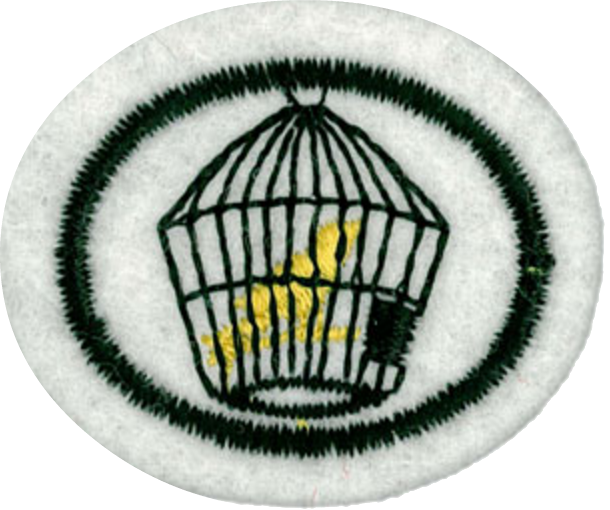Especialidades JA/Aves de jaula/Respuestas
Nivel de destreza
1
Año
1945
Version
03.12.2025
Autoridad de aprobación
Asociación General
1
2
- a. Si tiene una ave de jaula, mantener un registro de su cuidado por lo menos un mes. Incluir hábitos alimenticios, necesidades de agua, limpieza de la jaula, etc.
- b. Si no tiene una ave de jaula ahora pero completó el requisito #1 en el pasado, cuidar de una ave de otra persona por lo menos una semana mientras están de vacaciones, etc., y mantener el registro del cuidado requerido.
3
3a
3b
The same occurred in England. First the birds were only owned by the rich but eventually the local citizens started to breed them and, again, they became very popular. Many breeds arose through selective breeding.
3c
3d
4
4a
4b
5
5a
Adventist Youth Honors Answer Book/Nature/Birds/Wood Pigeon/es
Adventist Youth Honors Answer Book/Nature/Birds/Band-tailed Pigeon/es
| Streptopelia turtur (Turtle Dove) | |
|---|---|
| Description | |
| The Turtle Dove (Streptopelia turtur) is a member of the bird family Columbidae, which includes the doves and pigeons.
It is a migratory species with a western Palearctic range, including Turkey and north Africa, though it is rare in northern Scandinavia and Russia; it winters in southern Africa. In the British Isles, France, and elsewhere in northwestern Europe it is in severe population decline. This is partly because changed farming practices mean that the weed seeds and shoots on which it feeds, are scarcer, and partly due to shooting of birds on migration in Mediterranean countries. Smaller and slighter in build than other doves, the Turtle Dove may be recognized by its browner color, and the black and white striped patch on the side of its neck, but it is its tail that catches the eye when it flies from the observer; it is wedge shaped, with a dark center and white borders and tips. When viewed from below this pattern, owing to the white under tail coverts obscuring the dark bases, is a blackish chevron on a white ground. This is noticeable when the bird stoops to drink, raising its spread tail. The mature bird has the head, neck, flanks, and rump blue grey, and the wings cinnamon, mottled with black. The abdomen and under tail coverts are white. The bill is black, the legs and eyerims are red. The black and white patch on the side of the neck is absent in the browner and duller juvenile bird, which also has the legs brown. The Turtle Dove, one of the latest migrants, rarely appears in Northern Europe before the end of April, returning south again in September. It is a bird of open rather than dense woodlands, and frequently feeds on the ground. It will occasionally nest in large gardens, but is usually extremely timid, probably due to the heavy hunting pressure it faces on migration. The flight is often described as arrowy, but is not remarkably swift. | |
| Leptotila verreauxi (White-tipped Dove) | |
|---|---|
| Description | |
| The White-tipped Dove (Leptotila verreauxi) is a large New World tropical dove. It is a resident breeder from the southernmost Texas in the USA through Mexico and Central America south to western Peru and central Argentina. It also breeds on the offshore islands of northern South America, including Trinidad and Tobago.
The White-tipped Dove inhabits scrub, woodland and forest. It builds a large stick nest in a tree and lays two white eggs. Incubation is about 14 days, and fledging another 15. The White-tipped Dove has an approx. length of 28 cm (11 in) and a weight of 155 g (5½ oz). Adult birds of most races have a grey tinge from the crown to the nape, a pale grey or whitish forehead and a whitish throat. The eye-ring is typically red in most of its range, but blue in most of the Amazon and northern South America. The upperparts and wings are grey-brown, and the underparts are whitish shading to pinkish, dull grey or buff on the chest. The underwing coverts are rufous. The tail is broadly tipped with white, but this is best visible from below or in flight. The bill is black, the legs are red and the iris is yellow. The White-tipped Dove resembles the closely related Grey-fronted Dove, Leptotila rufaxilla, which prefers humid forest habitats. The best distinctions are the greyer forehead and crown, which contrast less with the hindcrown than in the Grey-fronted Dove. In the area of overlap, the White-tipped Dove usually has a blue (not red) eye-ring, but this is not reliable in some parts of Brazil, Argentina, Bolivia, Paraguay and Uruguay, where it typically is red in both species. The White-tipped Dove is usually seen singly or in pairs, and is rather wary. Its flight is fast and direct, with the regular beats and clattering of the wings which are characteristic of pigeons in general. The food of this species is mainly seeds obtained by foraging on the ground, but it will also take insects, including butterflies and moths. The call is a deep hollow ooo-wooooo. | |
5b
Some of this information is included in the a. answers but this topic needs to be addressed better.
6
In the United States:
- It is illegal to export any wild-caught, native birds.
- It is illegal to import any bird belonging to a threatened species, unless the bird was bred at a captive breeding facility approved by the U.S. government (the U.S. government periodically publishes a list of qualifying facilities).
- If the importation of a species of bird causes excessive mortality, importation shall cease.
- It is illegal to import birds into the United States from countries where their export is forbidden.
In Canada:
- Follow regulations on crossing the border with pet birds. http://www.inspection.gc.ca/animals/terrestrial-animals/imports/policies/live-animals/pets/birds-us/eng/1326661204161/1326661329675
References
- http://www.robirda.com/cancare.html
- http://www.fws.gov/international/laws/law102.html
- http://www.aacc.ca/intro.htm Avicultural Advancement Association of Canada
- http://www.cites.org/




